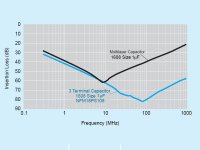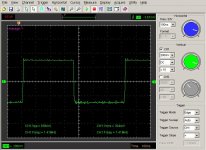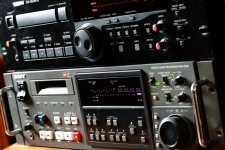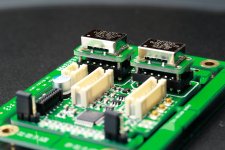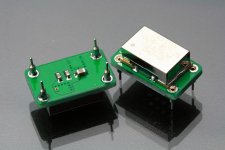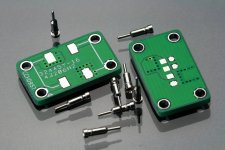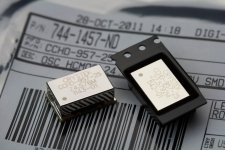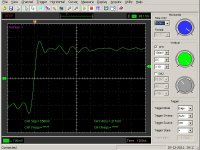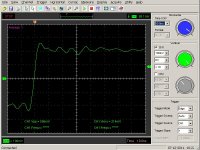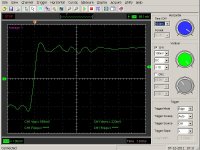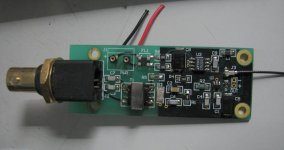Ian,
I think you tried the Crystek CCHD-957. What were your impressions?
BR,
George
I just get the back order from Digikey last week. I'm have to make an adapter. I'll let you know once I get the result. Any way, the specification was impressed
Ian
are C4 and C9 some sort of capacitor network? they appear to have 4 terminations
Very glad you noticed that. It's NFM filter from Murate. Somebody call it three terminal capacitor. Very good noise suppression performance. Much better than the normal decoupling capacitors due to its smart construction( 20dB in difference at 20MHz, and 40dB at 100Mhz). Highly recommended for clock power supply. You can find more details from http://www.murata.com/products/catalog/pdf/c31e.pdf
Attachments
Last edited:
Hi qusp,
Thanks again for the recommendation of the U.FL connectors. I'm very happy with them. It get the signal improved obviously. I use both U.FL conncetors and cables in almost all of my projects now.
no problem at all, indeed they are very useful. i can fit the w.fl on the u.fl pad so can use directly without an adapter which is cool.
Very glad you want the KIT. Once I go through the fully test on all the second edition PCBs and make sure everything is OK with bug free, I will consider setting up a group buy. I could figure out how much work I have to do going a small quantity production. Don't warry about your wallet, I'll give you a surprise.
sweet
Very glad you noticed that. It's NFM filter from Murate. Somebody call it three terminal capacitor. Very good noise suppression performance. Much better than the normal decoupling capacitors due to its smart construction( 20dB in difference at 20MHz, and 40dB at 100Mhz). Highly recommended for clock power supply. You can find more details from http://www.murata.com/products/catalog/pdf/c31e.pdf
well thats really interesting!! quite apt too, because i was actually just thinking about how i might get rid of the HF out of band fundamental in 'the wire' switching psu just for completeness.
I think i might ad a few to my DK order to have a play; thanks for that.
SPDIF Driver and digital transformer selection
To reduce that additive jitter, I use a 3GHz balanced LVPECL flip-flop, MC100EP31 as the SPDIF driver and re-clock logic.
I did the listening test by making use of PCM-7040 as a DAC, which was the top of the line broadcast grade DAT flagship from SONY and it's very sensitive to the SPDIF input, each different driver and transformer could be heard. Obviously, with the same set up, LVPECL driver sounds better than the traditional 74HCU04 CMOS driver.
Three SPDIF transformers were tested. They are Pulse PE65612, Newava S22083 and Newava S22160. Each of them sounds slightly different. The PE61612 is good, S22083 bit better. But the one I love the most is the S22160, which comes with more liquid and more musical.
I attached the driver schematics and the SPDIF signal waveform (after 5 feet coaxial cable with 75 ohm termination) for reference.
This test is still undergoing, I will try some other kinds of low jitter SPDIF driver and will select the best one to use finally.
SPDIF driver and the digital transformer are very significant for a SDPIF FIFO because they will introduce additive jitter after secondary clock.
To reduce that additive jitter, I use a 3GHz balanced LVPECL flip-flop, MC100EP31 as the SPDIF driver and re-clock logic.
I did the listening test by making use of PCM-7040 as a DAC, which was the top of the line broadcast grade DAT flagship from SONY and it's very sensitive to the SPDIF input, each different driver and transformer could be heard. Obviously, with the same set up, LVPECL driver sounds better than the traditional 74HCU04 CMOS driver.
Three SPDIF transformers were tested. They are Pulse PE65612, Newava S22083 and Newava S22160. Each of them sounds slightly different. The PE61612 is good, S22083 bit better. But the one I love the most is the S22160, which comes with more liquid and more musical.
I attached the driver schematics and the SPDIF signal waveform (after 5 feet coaxial cable with 75 ohm termination) for reference.
This test is still undergoing, I will try some other kinds of low jitter SPDIF driver and will select the best one to use finally.
Attachments
Ian,
Your findings with respect to the different transformers are interesting. In looking at the data sheets for each, it appears that the Pulse 65612 and the Newava 22083 are toroids (I am guessing from the fact that they are potted), but your favorite, the Newava 22160 is an open frame architecture. [Unless I am reading the data sheet incorrectly (certainly possible), the Pulse 65612 has an inductance of 2500 µH (listed as “2.5mH”), whereas the other two transformers have an inductance of 225 µH -- around a magnitude difference. Typo on data sheet?]
BR,
George
Your findings with respect to the different transformers are interesting. In looking at the data sheets for each, it appears that the Pulse 65612 and the Newava 22083 are toroids (I am guessing from the fact that they are potted), but your favorite, the Newava 22160 is an open frame architecture. [Unless I am reading the data sheet incorrectly (certainly possible), the Pulse 65612 has an inductance of 2500 µH (listed as “2.5mH”), whereas the other two transformers have an inductance of 225 µH -- around a magnitude difference. Typo on data sheet?]
BR,
George
Last edited:
Ian,
Your findings with respect to the different transformers are interesting. In looking at the data sheets for each, it appears that the Pulse 65612 and the Newava 22083 are toroids (I am guessing from the fact that they are potted), but your favorite, the Newava 22160 is an open frame architecture. [Unless I am reading the data sheet incorrectly (certainly possible), the Pulse 65612 has an inductance of 2500 µH (listed as “2.5mH”), whereas the other two transformers have an inductance of 225 µH -- around a magnitude difference. Typo on data sheet?]
BR,
George
Yes, from the specifications, they are. And, another thing I noticed, PE-65612 use double-wire for each coil, but S22160 use single wire (with bit bigger).
I have some PE65612 and measured them recently - the 2.5mH primary inductance figure is most certainly not a typo. As a result of its higher primary inductance, the leakage inductance is also higher.
In many applications, PE-65612 has been quite standarded digital audio transformer
Crystek CCHD-957 low phase noise oscillator and the adapter
Crystek CCHD-957 family oscillators were designed especially for high definition audio applications. From the specification, they have pretty impressed low phase noise performance.
I got the backorder from Digikey two weeks ago. It took me two month! But both Digikey and Mouser keep in stock now.
Of course you can solder it directly to a 14 pin IC socket by wires, but I think making an adapter would be much better. I got the adapter PCB today. The assembling is easy. First, I solder the CCHD-957 on the top of the PCB, then, flip it over, solder a 1n, a 104 and a 1u bypass capacitors on the back. And then, plug in four IC pins into the corner positions of a 14 pin IC socket and fit them into the four holes from the back of the adapter PCB. The last step is soldering the four pins to the pads at back. Now, with the adapter, CCHD-957 could be used as a standard 4 PIN DIP XO at anywhere.
I put both 22.5792 MHz and 24.5760 MHz CCHD-957 oscillators with adapter hookup into my double XO FIFO clock board. It looks nice. I caught cold yesterday and lost some listening sensitivity. I will do some comparison test on them once I’m getting better.
Attachments
looking good as always Ian, if i were to need an adapter for a clock, i would want it to look like yours =) is there any reason why you didnt use FFC/FPC all round for the ribbon type connections rather than a mix of regular crimped larger pitch ribbon and FFC/FPC? which brand did you use, hirose? any facility for shielded?
perhaps to allow more legacy type support for older dac modules you have? as they look to be in parallel to the u.fl so i guess that would make sense
perhaps to allow more legacy type support for older dac modules you have? as they look to be in parallel to the u.fl so i guess that would make sense
Last edited:
Yes, from the specifications, they are. And, another thing I noticed, PE-65612 use double-wire for each coil, but S22160 use single wire (with bit bigger).
It appears the reason is the fast rise/fall times.
Am I Experienced?: PE65612 vs. S22083/S22160
However the blogger recommends sc944-05 as a better replacement, here is the product page
http://amiexp.blogspot.com/2011/08/sc944-05.html
Re: Crystek CCHD-957, I am using it with PO74G04A and the sound is great.
http://www.diyaudio.com/forums/digital-line-level/142184-opening-new-dacmagic-37.html#post2810266
According to those graphs again is the fast rise/fall time that makes the difference.
Am I Experienced?: DSIX with PO74G04
Last edited:
looking good as always Ian,
perhaps to allow more legacy type support for older dac modules you have? as they look to be in parallel to the u.fl so i guess that would make sense
Thanks qusp,
Yes, exactly, that's the reason. To interface with legacy DAC or other finished PCB, connecting the wires from classical PH2.0 mm ribbon cables would be much easier than from FFC/FPC. But any way, if it is possible, I would be highly recommended to use the U.FL connectors and cables for better signal quality, EMI performance and less space taken. You can use either of them because they were paralleled each other.
The U.FL connectors on the double XO clock board are from I-PEX, thay are 100% compatible with those from Hirose. Hirose U.FL - Wikipedia, the free encyclopedia
Actually I tested samples from both and all of them are good. But personally I prefer I-PEX because I think gold plating would be a bit durable than the silver plating
The FFC/FPC connector on the clock board is only use for internal connection between the FIFO so there is no need concerned about the compatible problem.
Ian
It appears the reason is the fast rise/fall times.
Am I Experienced?: PE65612 vs. S22083/S22160
However the blogger recommends sc944-05 as a better replacement, here is the product page
Am I Experienced?: SC944-05
Re: Crystek CCHD-957, I am using it with PO74G04A and the sound is great.
http://www.diyaudio.com/forums/digital-line-level/142184-opening-new-dacmagic-37.html#post2810266
Hi gvelim,
Thank you so much for sharing your experience with us. Appreciate!
I aggree with you that Crystek CCHD-957 is one of the best, and I'd like to test the the digital transformer from SC, the one is just on the way, a very kind friend gave it to me, which is, as he said, was 'the best of best'
After seeing your waveform, I re-did the transformers test this evening by my regular 200Mhz bandwidth USB oscilloscope with 10ns/div and recorded the waveforms of PE65612, S22083 and S22160. The measurement point was at receiver side, after 5 feet 75 ohm coaxial cable with 75 ohm termination. My results were bit diffenent from yours. I atrached the waveforms just for reference. Yes, the PE65612 has a bit faster raising edge (but just quicker around 1ns ), not as that much as what was shown in your waveform. I tried both LVPECL driver and low jitter dedicate fan out buffer, the results were almost the same. It seems on your S22160 raising edge, there was a corner, usually this case was caused by the performance of the driver? which driver did you use? Could it delivery enough current at very high speed? Please note that that the primary inductance of PE65612 is 2.5mH, but the S22083 and S22160 are just 225uH. But any way, PE65612 is already good enough for many applications and has been quite standarded digital transformer for SPDIF.
Regards,
Ian
Attachments
Thanks qusp,
Yes, exactly, that's the reason. To interface with legacy DAC or other finished PCB, connecting the wires from classical PH2.0 mm ribbon cables would be much easier than from FFC/FPC. But any way, if it is possible, I would be highly recommended to use the U.FL connectors and cables for better signal quality, EMI performance and less space taken. You can use either of them because they were paralleled each other.
The U.FL connectors on the double XO clock board are from I-PEX, thay are 100% compatible with those from Hirose. Hirose U.FL - Wikipedia, the free encyclopedia
Actually I tested samples from both and all of them are good. But personally I prefer I-PEX because I think gold plating would be a bit durable than the silver plating. However, I-PEX could only be sourced from dealership.
The FFC/FPC connector on the clock board is only use for internal connection between the FIFO so there is no need concerned about the compatible problem.
Ian
thought so, yeah obviously the u.fl are ideal, i recommended them remember? hehe. but they arent always best, for common mode signals the FPC/FFC would be better i would imagine. there are several other brands of the u.fl since they are basically a standard in wireless devices and connecting wifi antennae in computers. there are some cheaper gold plate from emerson that are under the classification of UMC, which has landing pattern identical, so should me compatible, they are a bit cheaper and gold plate. then there is UMCC from TE connectivity that are even cheaper and gold again. but yes i've already tried the ones you mention, the cables are very nice and teflon from memory =)
Unless you have checked the system and particularly the scope I would not put too much analysis into the fast rise time abberations. It possible that the overshoot and preshoot are even in the scope itself (another ADC with many of the familiar digital issues). One is faster than the other but that may be as far as you can tell.
I have had to invest in a lot of stuff to be sure my instruments aren't lying to me.
I have had to invest in a lot of stuff to be sure my instruments aren't lying to me.
Scientific Conversions dual ZO are the business
yes the SC trannies are the best in the business imo. this one is the SC939-06 which has 110ohm primary and dual 110 and 75ohms secondaries. its SMD, but can fairly easily be retrofitted onto a standard 4 pin PTH pattern
i'm liking the look of the NDK NZ2520SD parts for clock vs the chrystek, just need to get up the numbers and they arent priced that badly. and yes i'm aware the termination resistor is wrong, i'm part way through changing it to a pseudo AES input (with XLR or course)
yes the SC trannies are the best in the business imo. this one is the SC939-06 which has 110ohm primary and dual 110 and 75ohms secondaries. its SMD, but can fairly easily be retrofitted onto a standard 4 pin PTH pattern
i'm liking the look of the NDK NZ2520SD parts for clock vs the chrystek, just need to get up the numbers and they arent priced that badly. and yes i'm aware the termination resistor is wrong, i'm part way through changing it to a pseudo AES input (with XLR or course)
Attachments
Last edited:
After a few long calls with Jon Paul of SC, he made it clear that the single impedance parts are the best, particularly the "super" part. The real value is the isolation which should make a difference in noise isolation.
The Crystek's are quite good but do cost. I would like to see the actual performance numbers of the NDK's.
The Crystek's are quite good but do cost. I would like to see the actual performance numbers of the NDK's.
i just bought a single unit to try and as mentioned its being tried with both BNC and AES, thus the dual. plus TBH i dont really care about uber spdif, as i believe its inferior to well implemented USB in every way. that being said its still the best unit ive tried.
oh haha, i'm wrong i do have a couple extra i got from acko. am i likely to actually notice the difference or is it academic? i have 2 x SC947-02, but might save it for something else where i can actually ground the shield, unless its really worthwhile
oh haha, i'm wrong i do have a couple extra i got from acko. am i likely to actually notice the difference or is it academic? i have 2 x SC947-02, but might save it for something else where i can actually ground the shield, unless its really worthwhile
Last edited:
well implemented USB
Any examples to share? I haven't seen one as the isolation gets fairly hairy.
yeah i'm running the crystek already on all 3 dacs in an 80MHz and 2 x 100MHz, but yes they are pricey, too pricey imo. i'm looking towards master synchronous clocking for 2 of the dacs which will run one per stereo set of speaker drivers in my 2 ways rather than dual mono, so i'm exploring options for the 3 clocks needed (one for each 22.1/24x and one for the DSP) they look great on paper, so i'd like to try, they are that much better than the crystek at low frequency in the datasheet that even if they are fudging it a bit they'll still be better for quite a bit less money
- Home
- Source & Line
- Digital Line Level
- Asynchronous I2S FIFO project, an ultimate weapon to fight the jitter
